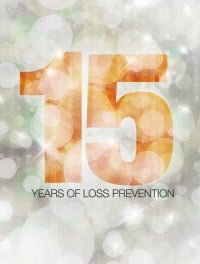Welcome to the second of three installments covering the first fifteen years of Loss Prevention magazine. I hope you enjoyed the first part in our September–October issue. We will now look at trends and changes in the industry through the eyes of the magazine beginning in 2007 up through 2011. The final installment will be in the January–February 2017 issue. In it we will cover the most recent years, look at current concerns, review technology advances, and take a look at what the future may hold for the retail LP industry. For this article we will stay with the same format as before and look at changes and developments in the industry focusing on some of the mainstay subjects that have appeared in the magazine over and over again.
Shoplifting and Organized Retail Crime
As we saw previously, organized retail crime has been the subject of numerous articles in the magazine. From the cover story by King Rogers in the very first issue through today, ORC continues to be a huge concern to most retailers. A recent 2016 statistic indicated that “professionals” were responsible for 3 percent of all shoplifting and 10 percent of all shoplifting dollar losses. I would bet that most retail loss prevention professionals who regularly deal with ORC would think those statistics are too low.
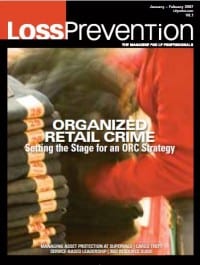 ORC, once again, made the very first cover of the second five years, the January–February issue of 2007. In that feature article, the first in a two-part series, John Talamo of Limited Brands gave a historical view of the subject. He also talked about ORC in specialty retail and outlined Limited Brands’ strategy to attack it. Talamo concluded his article in the March–April 2007 issue and discussed the training of Limited’s ORC team, investigation strategy and tactics, and partnerships with law enforcement.
ORC, once again, made the very first cover of the second five years, the January–February issue of 2007. In that feature article, the first in a two-part series, John Talamo of Limited Brands gave a historical view of the subject. He also talked about ORC in specialty retail and outlined Limited Brands’ strategy to attack it. Talamo concluded his article in the March–April 2007 issue and discussed the training of Limited’s ORC team, investigation strategy and tactics, and partnerships with law enforcement.
In the same issue, Bob DiLonardo talked about the formation of the Law Enforcement Retail Partnership Network (LERPnet). LERPnet was designed to be a national database aimed at fighting ORC and was a combination of the Retail Industry Leaders Association’s (RILA) InfoShare and the National Retail Federation’s (NRF) RLPIN. The FBI also collaborated on the project.
The November–December 2007 issue indicated that, according to the 2007 National Retail Security Survey (NRSS), 463,682 shoplifters were arrested in 2006, up 11.2 percent from the prior year. In the January–February 2008 issue, Karl Langhorst called for the need to enact more and stronger legislation to fight the growing ORC problem. The feature interview in the next issue, March–April 2008, saw Brad Brekke, then vice president of asset protection at Target, discussing the company’s forensic lab and overall response to ORC.
ORC was once again on the cover in the September–October 2008 issue. In that article, Jack Trlica talked about the seven-year lobbying effort that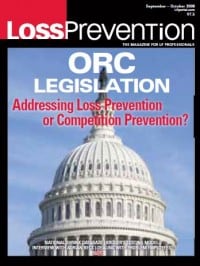 resulted in significant legislation introduced to the US Congress. This legislation was designed to criminalize ORC and associated activities.
resulted in significant legislation introduced to the US Congress. This legislation was designed to criminalize ORC and associated activities.
Articles dedicated to ORC slowed a bit in 2009. But the subject was back again in the January–February 2010 issue where Mike Marquis questioned how to determine the actual dollar loss caused by ORC. He talked about loss number estimates being all over the board, probably the result of how ORC is defined in various places. He then quoted the federal government’s official description of ORC.
The March–April 2010 issue featured a discussion on boosters versus fences, their link to ORC, and which is the greatest threat to shrink. The trend of having very few columns or articles dedicated to simple shoplifting continued. But in the July–August 2010 issue, a study at the University of Leicester in the UK was quoted as identifying common characteristics of shoplifters. They were commonly male, unpleasant, anti-social, disorganized, and unreliable. Who knew, right?
In a feature article in the January–February 2011 issue, Millie Kresevich discussed the importance of partnering with law enforcement to fight ORC and how one of these partnerships helped to dismantle an ORC operation in Florida. In the same issue, RILA’s Lisa LaBruno discussed shoplifting 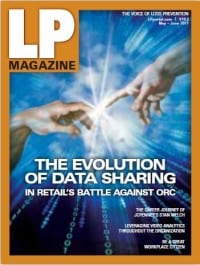 apprehension risks such as malicious prosecution and defamation. She also talked about the importance of individual integrity, restraint, and respect for others.
apprehension risks such as malicious prosecution and defamation. She also talked about the importance of individual integrity, restraint, and respect for others.
The cover story of the May–June 2011 issue written by Jack Trlica once again stressed the importance of data sharing between retailers and law enforcement to fight ORC and the importance of LERPnet in that effort. Flash mobs were described in the July–August 2011 issue as a new and growing trend in retail theft. In the September–October 2011 issue, Bob DiLonardo talked about a recently published book titled The Steal: A Cultural History of Shoplifting by Rachel Shteir. He thought it was well worth the read.
The second five years of the magazine’s coverage of ORC and shoplifting closed out with a cover story in the November–December 2011 issue. It talked about the formation of the Los Angeles Area Organized Retail Crimes Association (LAAORCA) resulting from a partnership between retailers and law enforcement and described the success it was having. The menacing shark depicted on the cover was a clever take on the LAAORCA acronym.
Crisis Management
The subject of crisis management got off to a bit of a slow start during the second five years of Loss Prevention magazine. This is probably attributed to the fact that so much was written about it in the previous five years after 9/11.
In the March–April 2007 issue, William Alford discussed the avian flu (bird flu, H5N1) epidemic and questioned whether it was a looming global crisis or another Y2K. At the time, potential death toll estimates totaled almost 1,800,000. Actual death totals recorded worldwide between 2003 and 2014 totaled only 407 according to the World Health Organization. William didn’t know it at the time, but it turned out to be closer to a Y2K scare.
The next big crisis made the cover of the January–February 2008 issue. It was Wendy’s “finger in the chili” incident. In the article, Chris Manning of Wendy’s detailed how the company managed the crisis step-by-step and discussed the company’s lessons learned. As most will remember, this incident turned out to be a total fraud. The husband and wife  perpetrators were both found guilty of grand theft, and each received a prison sentence of more than nine years.
perpetrators were both found guilty of grand theft, and each received a prison sentence of more than nine years.
Looking back at Hurricane Katrina and re-capping an earthquake in China and the Myanmar Typhoon, the July–August 2008 cover story by Ed Minyard questioned whether retailers were truly ready for the next big disaster and offered tips on how to prepare. Another kind of crisis made the cover of the November–December 2008 issue. This time it was the ongoing economic crisis. In the article, Jack Trlica talked about having to do more with less and gave some statistics coming out of a recent Loss Prevention Research Council (LPRC) meeting survey.
Assessing the workplace violence risk to your business was a feature article in the September–October 2009 issue. It discussed risk vulnerability and the potential impact of a major incident on a business. The March–April 2010 issue saw the Food Marketing Institute (FMI) discussing its recently released Supermarket Security and Loss Prevention report, which explored the breadth and sophistication of crisis planning in the industry. In the September–October 2010 issue, Dr. Richard Hollinger of the University of Florida described a workplace violence shooting in Connecticut that killed nine people. He discussed lessons to be learned from that particular incident. He also called for increased attention to the growing workplace violence trend.
Closing out the crisis management subject for this period was the September–October issue of 2011—ten years after 9/11. In it, many of the loss 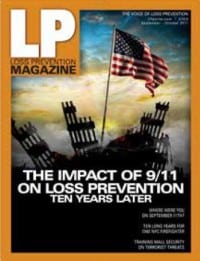 prevention industry leaders discussed where they were on the morning of 9/11/2001 and their reactions to the tragic events of that day. In the same issue, Jack Trlica discussed the impact of 9/11 on the loss prevention industry ten years later. He talked about everything from business continuity and employee communications to public-private partnerships and travel safety. The final crisis topic discussed in that issue centered on the training of mall security around how to respond to terrorist threats.
prevention industry leaders discussed where they were on the morning of 9/11/2001 and their reactions to the tragic events of that day. In the same issue, Jack Trlica discussed the impact of 9/11 on the loss prevention industry ten years later. He talked about everything from business continuity and employee communications to public-private partnerships and travel safety. The final crisis topic discussed in that issue centered on the training of mall security around how to respond to terrorist threats.
Fraud
Fraud, an ongoing major concern of all retailers, got its fair share of coverage in the magazine’s second five years, although seemingly at a reduced pace. One of the first major articles on fraud appeared in the January–February 2009 issue and discussed credit card skimming. In it, Catherine Penizotto from Kmart talked about its definition, the growing problem, where and how it occurs, and its impact on retailers. She also offered suggestions to protect individuals and businesses from it.
The battle against online payment fraud was a feature article in March–April of 2009. It outlined a case study from Urban Outfitters. Various steps to 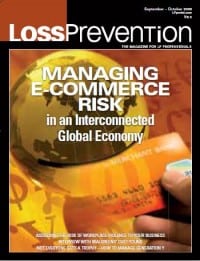 prevent online payment fraud were suggested including examining chargebacks, adjusting thresholds, adopting best practices, and using state-of-the-art technology.
prevent online payment fraud were suggested including examining chargebacks, adjusting thresholds, adopting best practices, and using state-of-the-art technology.
The September–October 2009 cover story was written by none other than Tom Ridge, the first Secretary of the Department of Homeland Security. Ridge talked about e-commerce risks in an international global economy, including spam, phishing, and examples of data theft. He also described the increasing fraud rates from card-not-present transactions. Further discussion on the prevention of online order fraud occurred in an article from the May–June 2010 issue. The author listed red flags often present in fraudulent online transactions and described each one in detail. Tips on investigating fraudulent online transactions were also included. The growth of online fraud in Europe and countermeasures to guard against it was the subject of an article in the March–April 2011 issue. It was apparent from the article that online fraud had become a major worldwide issue.
The National Retail Security Survey (NRSS) and Employee Theft
In the second five years of the magazine, just like the first five, Richard Hollinger, PhD, continued writing his column focusing on employee dishonesty and publishing the yearly National Retail Security Survey (NRSS). And the Wicklander-Zulawski team continued to write an interview and interrogation column in every issue.
In the January–February issue of 2007, Dr. Hollinger reversed the question of why retail theft is so high and asked, “Why isn’t it higher?” He went on to describe eleven myths that most shoppers and employees think are true. Beliefs such as “most people think they will get caught” and “CCTV cameras really work” made the list. It is very interesting reading.
In the July–August 2007 issue, Millie Kresevich was back exploring the theory that a bad corporate culture may be the cause of increased employee dishonesty. She offered tips on creating a culture of integrity and trust.
In the November–December 2007 issue, Dr. Hollinger gave an overview of the 2006 NRSS results to which 151 retailers responded. Overall average shrink percentage was reported as being 1.57 percent of sales, down slightly from the 1.59 percent of 2005 but higher than the all-time low of 1.54 percent in 2004. In the 2006 survey, retailers attributed 47 percent of loss to employee theft and 32 percent to shoplifting.
The November–December 2008 issue revealed the 2007 NRSS results. Participation dropped slightly to 134 retailers who reported an average shrink of 1.44 percent of sales, a new all-time low. Employee theft was listed as causing 44 percent of loss (down from 47 percent), while losses from shoplifting rose to 34 percent (up from 32 percent).
The results from the 2008 NRSS survey recapped in the September–October 2009 issue showed participation slightly down, possibly due to industry consolidations during the recession. Overall shrink inched up to an average of 1.51 percent of sales. Internal theft percentage continued to go down (to 42.7 percent) and external theft continued to grow (to 35.6 percent).
The January–February issue of 2010 included the results of the Global Retail Theft Barometer for the period June 2008 through June 2009. Just over 1,000 retailers from 41 countries participated in the survey, which showed an overall average shrink percentage of 1.43 percent of sales. Both North America and the rest of the world showed overall internal theft percentages shrinking and external theft percentages rising.
Fast forward to the results of the 2010 NRSS. Overall shrink was 1.49 percent of sales. Employee theft as a cause of shrink came in at 45 percent, and 31 percent was attributed to shoplifting, reversing the trend in the past few surveys.
Loss Prevention Technology
Articles featuring or discussing loss prevention technology continued to be plentiful from 2007 through 2011. The March–April issue of 2007 noted that the Japanese government was joining with several high-tech companies and retailers to test RFID tags, Wi-Fi, and Bluetooth technologies in an attempt to enhance security and provide shoppers with information as they strolled through Tokyo’s fashionable Ginza district.
In the May–June 2007 issue, Rite-Aid’s Cathy Langley wrote the cover story on exception reporting. She described the development and rollout of Rite Aid’s front-end tool and pharmacy analysis tool. She discussed the importance of developing key performance indicators (KPIs) to analyze where loss was occurring. She also discussed the value of exception reporting to other departments beyond LP.
The discussion of RFID returned in the July–August 2007 issue where Bob DiLonardo described efforts to use RFID technology to create “benefit denial” deterrents for highly theft-prone DVDs.
The September–October 2007 issue’s cover story outlined Zale Corporation’s aggressive use of an in-house remote video monitoring system to help both loss prevention and operations. In the same issue Bob DiLonardo admitted that he was a little tired of hearing about RFID but thought it was inevitable that it would become a fact of life. He referenced a newly published book where the authors described all the basic components of RFID in understandable language.
 In January–February 2008, DiLonardo reported that a Silicon Valley company announced the creation of a new process that allowed production of RFID circuits for a fraction of the cost of conventional technology. Items targeted included item-level tagging in retail, consumer products, healthcare, and transportation.
In January–February 2008, DiLonardo reported that a Silicon Valley company announced the creation of a new process that allowed production of RFID circuits for a fraction of the cost of conventional technology. Items targeted included item-level tagging in retail, consumer products, healthcare, and transportation.
The May–June 2008 issue reported that a new organization was formed between numerous US and European companies interested in promoting a so‑called “electronic product code” (EPC), an RFID-based replacement for the barcode.
In the July–August 2008 issue, the statement was made that the overall demand for electronic security products and systems was expected to grow at a rate of 7.8 percent a year and reach $15.6 billion in sales by 2012.
The Great Recession was just ending when Lee Pernice asked the following question in the March–April 2009 issue: “How can we use technology to stretch paper-thin budgets even further?” She talked about emerging technologies in video cameras, digital recording, video analytics, remote monitoring, and of course, last but not least, RFID, which she predicted was “still coming.”
In the July–August 2009 issue, it was announced that two more European fashion retailers made news by announcing item-level RFID deployments. In the same issue, Bob DiLonardo included the following quote in his column: “Intelligence is going to be ubiquitous, connecting the supply chain directly to the sales process, tying merchandise to the employee who sold it and the customer who purchased it.” DiLonardo noted that the quote was published twelve years earlier and, as of 2009, we were basically still waiting.
In the November–December 2009 issue, GAP’s loss prevention finance director talked about making the right EAS decision for your stores. The advantages and disadvantages of in-store tagging versus source tagging and soft tags versus hard tags were discussed. In the end, GAP landed on a blended solution in an attempt to maximize the benefits of each option.
Biometric access control was heralded as “the next great thing to reduce shrink” in the March–April 2010 cover story. Kevin Plante described the benefits in detail, how it could be used, and the hardware and software needed to make it happen.
While most articles on technology sung its praises and extolled its value, Bob DiLonardo, in his July–August 2010 column, questioned whether technology was actually affecting people negatively. Addiction to the Internet was called out as the biggest threat, and psychologists indicated that excessive use of technology was causing behavioral changes in people ranging from impatience, forgetfulness, separation anxiety, and escapism to out-and-out addiction.
In the September–October 2010 issue, Jim Lee interviewed Brand Elverston of Walmart. They discussed the search for new loss prevention tools and the need to develop next-generation technology. It is interesting to note that RFID was not mentioned once in the interview.
RFID was back in Bob DiLonardo’s column in the May–June 2011 issue. In it, he reported that item-level RFID was emerging from the proof-of-concept and pilot stages and was gaining momentum all over the world. He indicated that a recent poll found that 57 percent of retailers were using or planned to use RFID at the item level. In the July–August issue of 2011, American Apparel said it would add another fifty stores to its item-level RFID program.
For the final installment in this series, to appear in the January–February 2017 issue, I will do some research in order to report on where retailers really are today regarding the RFID subject.
Shrink Reduction and Loss Prevention Programs
In the March–April issue of 2007, Paul Stone from Best Buy described the company’s effective four-part approach to reducing shrink: (1) a specific and detailed shrink plan; (2) store managers talking about shrink every day; (3) numerous cycle counts; and (4) store general managers involved in hiring interviews.
 In the July–August 2007 issue, Mike Keenan, then at Mervyn’s, described an auditing program to monitor operational compliance as being a critical part of any successful loss prevention program.
In the July–August 2007 issue, Mike Keenan, then at Mervyn’s, described an auditing program to monitor operational compliance as being a critical part of any successful loss prevention program.
In September–October 2007, Adrian Beck and Colin Peacock wrote about common practices of low-shrink US retailers. Some of these practices included senior management commitment, ensuring organizational ownership, embedding loss prevention commitment in the business, providing strong leadership, constantly talking shrink, and not being afraid of innovation and experimentation.
Next we jump to the September–October issue of 2008 where Ken Cornish of Kroger described Kroger’s partnership with the Loss Prevention Research Council. Together they formulated very specific and documented product-protection approaches that were formally tested and rated to see which methods proved most effective in deterring theft while not negatively affecting sales.
In the November–December 2009 issue, Adrian Beck and Colin Peacock were back talking about their new book New Loss Prevention, where they challenged existing ideas about shrink and emphasized operational failure as a major contributor of loss.
An article in the May–June 2010 issue titled “Thou Shall Not Steal” featured Melissa Mitchell of LifeWay Christian Stores talking about her company’s loss prevention program that consistently produced one of the lowest shrinks in the industry. Mitchell talked about a culture of honesty and concern for people as driving forces behind LifeWay’s shrink success.
In a July–August 2011 interview, Gary Johnson, then at Vitamin Shoppe, talked about the importance of people over technology as the key component of an effective shrink-reduction program. In fact, when asked by Jim Lee what anti-shrink technology had been implemented at Vitamin Shoppe, Johnson’s response was, “We haven’t implemented any, and that’s by design.”
People, Education, and Diversity
As mentioned in the first article in this series, no discussion about the retail loss prevention industry would be complete without a focus on its people, its educational efforts, and the continued need to improve the diversity of its population. In the January–February 2007 issue, Ed Rehkopf offered up the thought that an organization with a service-based leadership style produced happier and more productive employees. Some parts of that leadership style include continuous recognition of employees, an open flow of ideas, highly regarding both risk and innovation, prestige derived from performance instead of title, and employees who are made to feel they are a part of a team.
In a May–June 2007 article, Bruce Tulgan talked about the pitfalls of getting so busy that you forget your people. According to Tulgan’s theory, the first person you need to manage is yourself, and then manage everyone else. He also opined that team meetings are fine but are no substitute for genuine one-on-one interactions.
The March–April 2008 issue found Dan Poelstra describing his thoughts on how LP managers can become retail executives. Poelstra outlined some basic building blocks of that journey, such as setting priorities, knowing the retail business, getting a higher education, networking, and polishing up your communication skills.
A focus on people continued to be front and center when, in the July–August 2008 issue, David Katz, CEO of the Global Security Group, discussed protecting international business travelers. Katz talked about the importance of increased awareness, making sure you are not being followed or watched, avoiding routine patterns, basic vehicle safety measures, and pre-travel research and planning.
Appropriately at the end of the Great Recession, a May–June 2009 article talked about having an unemployed contingency plan. Author Jason Jakus offered up four critical thoughts or lessons: (1) don’t take it personally; (2) ask questions and know your rights; (3) dive into your finances; and (4) start your job search yesterday.
In the September–October 2009 issue, Bruce Tulgan was back with tips on how to manage generation Y in an article titled “Not Everyone Gets a Trophy.” To effectively manage those born in the 1980s and 1990s, Tulgan offered many tips including being selective, trying to scare them away before hiring and keeping the ones who didn’t run, getting them committed to your mission, not fighting their lust for high tech, giving them structure and boundaries, and finally, doing whatever it takes to hold on to the best and the brightest.
In his feature article that appeared in the July–August 2010 issue, Jim Lee talked to regional and district-level LP executives about their perspectives on climbing the corporate ladder. Things like being an effective coach, getting a higher education, being willing to be the cause of change, mastering the skills needed at every level, not job hopping too much, and trying hard to balance personal and work life were discussed at length.
In the November–December 2010 issue, Bob DiLonardo offered up a very insightful and educational article on “Basic ROI Knowledge for Front Line Management.” He described net present value, internal rate of return, and shortage reduction benefit calculations, and talked about how to use them.
Another very useful and instructional article came from Liz Martinez in the November–December 2011 issue. Martinez wrote about the “Ten Steps to Training Employees to Write Good Reports.” Some of the things she talked about were explaining the purpose, knowing the audience, painting a picture, being accurate in language and punctuation, and including feeling.
Speaking of education, 2006 saw the Loss Prevention Foundation become a reality. But it was between 2007 and 2011 when it truly came of age with  the launching of the LPQ and LPC certification programs. Every issue from 2007 through 2010 included a column talking about the continued development of not only the foundation itself but also the philosophy behind it and the importance to the industry of LPQ and LPC certification. Jim Lee’s feature interview in the July–August 2009 issue found Loss Prevention Foundation President Gene Smith talking about its mission, the journey, LPQ and LPC certifications, how they were created, and the importance of continuing education to the LP industry. And then, the cover story of the January–February 2010 issue proclaimed “LP Certification Is Now a Reality.” In that article, Jack Trlica talked about the certification development process being a total industry effort and went on to describe the specific components of both the LPQ and LPC. He also talked about the board members, costs, and available scholarships. All issues of the magazine in 2010 and 2011 featured a column on certification, often written by someone from the industry talking about the importance of getting certified.
the launching of the LPQ and LPC certification programs. Every issue from 2007 through 2010 included a column talking about the continued development of not only the foundation itself but also the philosophy behind it and the importance to the industry of LPQ and LPC certification. Jim Lee’s feature interview in the July–August 2009 issue found Loss Prevention Foundation President Gene Smith talking about its mission, the journey, LPQ and LPC certifications, how they were created, and the importance of continuing education to the LP industry. And then, the cover story of the January–February 2010 issue proclaimed “LP Certification Is Now a Reality.” In that article, Jack Trlica talked about the certification development process being a total industry effort and went on to describe the specific components of both the LPQ and LPC. He also talked about the board members, costs, and available scholarships. All issues of the magazine in 2010 and 2011 featured a column on certification, often written by someone from the industry talking about the importance of getting certified.
We have talked more than once about the need to continue to push for a more diverse retail LP industry. By the time 2007 came along, Mimi Welch, who had written a diversity column in every issue of the magazine during the first five years, had moved on. But Jim Lee has often talked about the subject in his Parting Words column over the years. Also, four very high-ranking women LP professionals were the subject of interviews or feature articles from 2007 to 2011. They included Carol Martinson, VP of asset protection at SUPERVALU in January–February 2007; Joan Manson, VP of LP, payroll, benefits and legal at the Container Store in November–December 2009; Melissa Mitchell, director of LP and inventory control at LifeWay Christian Stores in May–June 2010; and in March–April of 2011, Monica Mullins, VP of asset protection and safety at Walmart, who at the time oversaw the biggest retail LP organization on the planet.
But, yes, we know we can do better. To that end, it’s interesting to note that there was a very serious and spirited discussion at a recent Loss Prevention Foundation board of directors meeting around holding all executives in our industry accountable for making improved diversity a reality. Everyone present committed to making that happen. And many people in that room also serve on the editorial board of Loss Prevention magazine.
Thanks for taking the second part of this journey with me. As mentioned before, in the upcoming third installment we will review the last five years of the magazine, do a reality check on RFID and some other LP technology, and take a look at the future of our industry. Again, most of the articles mentioned here are available at LossPreventionMedia.com, the magazine’s website. PDFs are available by contacting editor (at) LPportal (dot) com.


